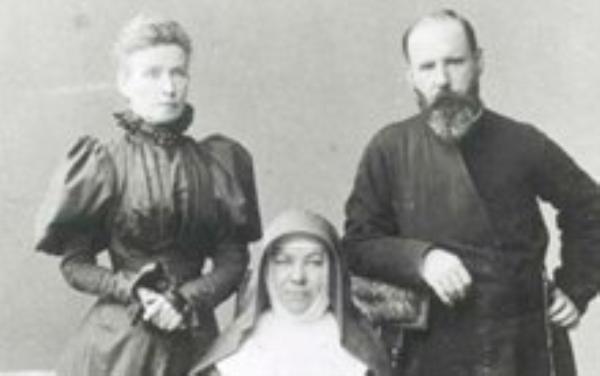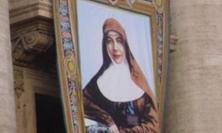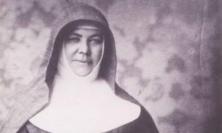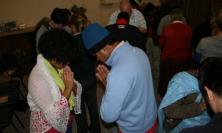As Australia prepares to celebrate the canonisation of its first saint, Mary MacKillop, much media attention has been devoted to Mary’s story, but little is known about the fascinating life of her younger brother, Jesuit priest Donald MacKillop, to whom Mary was very close. Australian Bishop, Greg O’Kelly SJ, describes Donald’s instrumental role in a nineteenth century Jesuit mission among the Aboriginal people of the Northern Territory, his ‘New Paraguay’.
It is an irony of Australian history that in 1891, the very year that the disillusioned social reformer, William Lane, was leading two hundred and twenty Australians to South America in order to found a utopia there – the New Australia in Paraguay – a Fr Donald MacKillop SJ was leading a group of twelve fellow Jesuits to found what he termed a New Paraguay in Australia! Neither knew of the other. Donald MacKillop was one of the two younger brothers of the woman who on Sunday 17 October will become Saint Mary of the Cross MacKillop.
Donald and Mary
Donald and Mary were very close to one another, and several of their affectionate letters survive, along with photographs that were taken from time to time of Mary and Donald together. Born in Melbourne in 1853, Donald had the same upbringing as Mary and their other siblings, receiving a remarkable education at the hands of their father, Alexander, a man who was culturally accomplished but hopeless in business ventures and irresponsible with regard to his commitments to his family. His imprudence and absenteeism reduced the family to consistent poverty, such that Mary had to undertake an adult’s role and work to support her brothers and sisters. Donald was fourteen years old when he and his younger brother, Peter were sent from Portland, Victoria, to board at St Aloysius College, Sevenhill, a college for boys just opened by Jesuits expelled from their Austrian homeland. The Jesuits had come to South Australia as refugees in 1848, serving as chaplains to an immigrant party of Prussian Catholics.
Donald was to display a number of the features which reflected the Highland Scottish background of his father – he was courageous, headstrong, passionate about his causes and stubborn. Mary also displayed a number of those same qualities. Donald was proud of the feat he had performed at the age of thirteen, when he rode on horseback from Portland to Penola in South Australia (some 95 miles) to join up with Mary, who was teaching there. In Penola he had come into contact with Fr Julian Tenison Woods, the priest who inspired the idea of the Sisters of Saint Joseph of the Sacred Heart in Mary’s mind and heart, and it was doubtless Wood’s suggestion that resulted in the two MacKillop boys being sent to board at Sevenhill.
Donald was in his last year of school when his sister Mary was excommunicated by Bishop Sheil. It would be interesting to know the way in which the Jesuits at the College addressed that event with Donald and Peter. The Jesuits remained consistent supporters of Mary and recognised that the excommunication was invalid due to lack of process and content, and they continued discreetly to give Mary Holy Communion at their church in Norwood, Adelaide. They recognised the powerful impact that the Sisters could make in establishing little schools in remote hamlets across the vast areas of the region that had been entrusted to the pioneer Jesuits: early colonial mid-north and northern South Australia. Mary founded some 22 schools in this area, which later became the Diocese of Port Pirie.
What he saw of the Jesuit priests and brothers at Sevenhill began to tug at Donald’s heart and he became one of the first three Australians to enter the Jesuit Order. His first ten years as a Jesuit were spent at Sevenhill: as a novice, then as a student of philosophy and humanities, and then teaching the boys in the school. He was then sent to Europe to complete his studies in theology at Innsbruck and then in Wales and London.
Mary did not confide all her troubles to Donald in his earlier years as a Jesuit, but their later letters reveal that she was taking him more and more into her confidence about the challenges facing her and the Sisters of Saint Joseph. Donald is fully supportive of her in his letters and clearly most interested in her activities and well-being. Revealing of their close relationship is a letter he wrote immediately after the ceremony of his ordination at St Beuno’s, North Wales, on 20 September 1885. He writes:
Immediately on returning to the Sacristy after the Ordination Mass, and before anyone else could get my blessing, I wrote it down for you. I intended filling out the sheet but it was only in pencil and got so crumpled that I have rewritten the blessing – but knowthat you have my first blessing. Before I could write the second – the one I enclose – Reverend Father Provincial was kneeling for me for the blessing of a new priest.
The mission in the Northern Territory
In 1882 the Jesuits from South Australia, along with priests and brothers directly from Austria, undertook a mission among the Aboriginal people of the Northern Territory. Instrumental in starting this mission was Fr Vincent McNab, a Scottish diocesan priest who was a relative and family friend of the MacKillops, and who himself worked devotedly amongst the Aboriginal people. The mission in the Northern Territory was only the second Catholic mission in Australia at that time. The Church was concentrating on its European population, and the need for new schools and parishes for them. The Church’s record with the Aboriginal people in terms of missions stood in sorry contrast to that of their Protestant brethren.
Donald was 33 when he arrived to join this mission in Palmerston, Darwin in 1886, full of energy and zest. He commenced language studies and from time to time was made acting Superior of the mission, even in his first years. The approach of the Jesuits was quite advanced for its time: to found small mission stations in the different tribal areas, respecting the language of the local people and undertaking to learn the language themselves, which was a task not usually engaged in by missionaries then. The missionaries later said that it took them four years and 26 editions before they believed they had translated the ‘Our Father’ correctly into the aboriginal tongue!
The mission was plagued with debt due to its isolation and distance from other main centres. The station on the Daly River was on the west side, and the priests and the brothers were the first Europeans to live in that area among the Aboriginal people. Donald was commissioned to commence another station twenty miles west of the Daly, which he did, but it was becoming obvious that three small stations were unviable economically. Having been made Superior in 1891, he promptly closed all three stations and concentrated his human resources into a new commencement, on the east side of the Daly, his ‘New Paraguay’.
It was here that Donald was able to embark upon what he later called ‘the daydream of my life’, to imitate on the banks of the Daly the famous Jesuit Reductions of Paraguay, the story of which was portrayed in part in the film, The Mission. In the seventeenth and eighteenth century the Jesuits founded some forty of these small states, as a means of segregating and protecting the Indians from Spanish slavers. The ruins are still magnificent: townships with laid out roads and street lighting, public buildings, workers’ guilds, workshops and even armed forces, all conducted along strictly socialist lines of common property and distribution of profits. Each was governed as a small theocratic state with its own elected leaders and councils, under the guidance of usually just two Jesuits, a priest and a brother. In 1733 there were forty of these Reductions with a total population of one hundred and twenty-six thousand indigenous people.
Donald referred to the Paraguay model frequently in his letters. He adopted many of the features of the Paraguay Reductions on the Daly – the size of the farms, the marriage age, the terminology. Antipathy, condoned violence, the demeaning and condescending manner of whites towards the Aboriginal people, and the view of the Government’s role as being simply ‘to soothe the dying pillow’, were continuing to take a dreadful toll on the Aboriginal people in terms of their physical and psychological survival. Donald confronted this attitude head-on in a series of letters to papers such as the Sydney Morning Herald, The Age and The Advertiser, as he castigated the whites for their attitude.
Why then continue? Ask the leader of a forlorn hope why he rushes to almost certain death. Because, he will tell you, after all he leads a hope. So it is with us. Present legislation, even when it means to be kind, is simply death and extermination to the black man. But public opinion, the true ruler here, may change all this… our aim and our hope is to reproduce on the banks of the Daly and among the western tribes those Reductions - triumphs of humanity, even Voltaire called them – which, as Henry George writes, ‘to their eternal honour the Jesuits instituted and so long maintained in Paraguay.’ If only South Australia would allow us room…
Imagine a letter such as the following, written in 1892, being published today:
Australia, as such, does not recognise the right of the black man to live. She marches onward truly, but not perhaps the fair maiden we paint her. The black fellow sees blood on that noble forehead, callous cruelty in her heart, her heel is of iron and his helpless countrymen beneath her feet. But we are strong and the blacks are weak; we have rifles, they but spears; we love British fair play, and having got hold of this Continent we have every square foot. The little Tasmania is our model, and, I fear, will be, until the great papers of Australia will chronicle, ‘with regret’, the death of the last black fellow.
Mary was very supportive of Donald, and even planned to send Josephite Sisters to help look after the Aboriginal women on the mission. The plan never eventuated, the principal reasons being the fear of Jesuit Superiors for the safety of the Sisters in the isolation, and the precarious future of the mission.
The mission after Donald
A strenuous worker and visionary, the work load on Donald soon began to play havoc with his health, and he suffered from the neuritis that also afflicted Mary. In the end it was excruciating kidney stones which simply could not be treated in his remote mission, and Palmerston had no doctors able to perform the necessary procedures so Donald had to leave the mission permanently. By then, he had almost made a success of the mission in physical terms: importing steam engines, planting tobacco and sugar cane, increasing the herds of goats and camels and donkeys. An extract from the Mission Journal illustrates the high spirits Donald brought to the mission when he was appointed and how straitened their conditions were:
4 June 1891, Thursday. News of the arrival of the boat and of Father MacKillop. At 8.00pm, to the accompaniment of gunfiring and the children’s singing, Father MacKillop was escorted here by Father Conrath. Brother Longa was with him. At supper our last bottle of wine was opened, and recreation was prolonged for an hour more than usual, all being in good spirits. Brothers Scharmer and Haelbig spent the night at the port, on guard.
It did not take much for them to party on, one bottle of wine among the thirteen!
But after Donald left the mission in 1896, without the optimism or strength with which he had commenced, a certain disillusion crept over the missionaries, as they saw what they described as inconstancy amongst the people with whom they were dealing. The model of the mission was that of an agricultural colony, and the attempt to turn a people used to hunting and foraging into settled farmers was simply an impossible dream, and one not matched to the cultural expressions of the Aboriginal people. The subsequent mediocre leadership, increasing poverty and the economic depression of the 1890s all conspired to cripple the mission, which was finally ended by two disastrous floods in 1898 and 1899, inundations which destroyed everything they had planted.
Donald after the mission
Donald MacKillop was well versed in music, humanities and science. His paper, ‘Anthropological Notes’, concerning the tribes of the Daly River was published by the Royal Society of South Australia. After some time convalescing, Donald was appointed to Jesuit parishes in Melbourne and Adelaide, and at Sevenhill. He continued to work in indifferent health. He was celebrating Mass at Farina in South Australia on 8 August 1909 when, during the Mass, he had an intimation that his sister Mary had died. When the telegram came informing him of her death, he noted the coincidence of times.
Donald MacKillop was remembered by the people of Richmond and Norwood as a kindly and devoted priest. He died at Norwood on 17 February 1925, aged seventy-one, and is buried in the Jesuit plot at West Terrace.
Bishop Greg O’Kelly SJ is bishop of the Diocese of Port Pirie, Australia.






